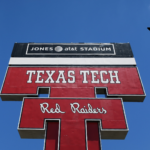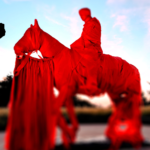On the Gridiron
 100 days as of yesterday.
100 days as of yesterday.
On the Course
 Texas Tech golf is in Carlsbad, California as part of the Men’s NCAA Golf Championship, competing against 30 teams. Texas Tech is the 8th best team going into the tournament.
Texas Tech golf is in Carlsbad, California as part of the Men’s NCAA Golf Championship, competing against 30 teams. Texas Tech is the 8th best team going into the tournament.
On the Diamond
 Texas Tech baseball continues to stay alive, beating Cincinnati 10-5 yesterday and will play Oklahoma State (yet again) today at 4:00 p.m.
Texas Tech baseball continues to stay alive, beating Cincinnati 10-5 yesterday and will play Oklahoma State (yet again) today at 4:00 p.m.
On the Court
 Lubbock Avalanche Journal’s Nathan Giese wrote about Grant McCasland’s desire to continue to add size with the last 3 spots available:
Lubbock Avalanche Journal’s Nathan Giese wrote about Grant McCasland’s desire to continue to add size with the last 3 spots available:
With 10 slotted scholarships accounted for, Texas Tech has three more spots available to add more through the transfer portal. McCasland said the plan is to fill all 13 spots, but only if the right players present themselves. No giving spots away just to fill a roster spot.
Given Cambridge’s knee, Yalaho still adapting to the college game and this past season’s struggles with depth, McCasland said how the Red Raiders use those final three roster positions is obvious. Yalaho, listed at 6-foot-8, is the only other player outside of Federiko taller than 6-6.
“We experienced the Big 12,” McCasland said, “and you’ve got to have size. I think if we’re going to add any depth, it’s really going to be at the size. … I think we just need to add size and depth at those positions. And then if we can find the best available late in the summer that we feel can just help us win, we would do something with that, but not necessarily feeling like we have to do anything right now.”
 Also from Lubbock Avalanche-Journal’s Nathan Giese is how assistant coach Jeff Linder arrived at Texas Tech from Wyoming:
Also from Lubbock Avalanche-Journal’s Nathan Giese is how assistant coach Jeff Linder arrived at Texas Tech from Wyoming:
In those five days, it became apparent things weren’t great between Linder and the Cowboys. McCasland provided some clarity on the situation earlier this week in his first availability of the offseason.
“I think what happened in his scenario is just completely unique to (name, image and likeness),” McCasland said. “How do you build a team and what are the opportunities that each university has to build it? I think ultimately, he was at a transition time where he’s trying to figure out how to navigate this new landscape and we were able to convince him to come to Tech and be a part of winning a national championship.”
NCAA Settlement
 Yahoo’s Ross Dellenger and ESPN’s Pete Thamel on the agreement by the Power 5 conferences of the House vs. NCAA case. I’m going to quote Thamel on this article to give you all some variety:
Yahoo’s Ross Dellenger and ESPN’s Pete Thamel on the agreement by the Power 5 conferences of the House vs. NCAA case. I’m going to quote Thamel on this article to give you all some variety:
But the reality of the culmination of votes on Thursday, which still need the approval of Judge Claudia Wilken, is that college leaders took the best bad option. Pay billions now and share the revenue or, lawyers predicted, lose a series of lawsuits, declare bankruptcy and start over.
How we got here is simple. As college sports roared from regional passion to national obsession through the 1990s and this century, NCAA leaders and college presidents clung to a business model that didn’t pay the talent. (The coaches, not coincidentally, were compensated at significant levels because the players never commanded a salary.)
Just three years ago, the NCAA fought the notion of paying athletes a now-quaint $6,000 in academic-based awards all the way to the Supreme Court. So it’s hard to overstate just how drastic the tenor change is surrounding college sports.
And there are still things to solve:
How does Title IX factor into the financial calculus? That looms as the biggest campus worry. How will rosters be constructed? Football coaches who have 130 players on their team — 85 scholarships and 45 walk-ons — are wondering if they need to cut a third of the roster with the expected inclusion of roster caps.
“This all is well intended, but I’ll believe it when I see it,” an industry source told ESPN. “There are three big issues looming that will determine how this goes: The Title IX strategy for the implementation of revenue distribution, enforcement issues surrounding residual NIL and how roster caps work.”
If NIL remains outside athletic departments, as expected, who will police it? The NCAA’s enforcement track record is nearly as poor as its legal record. Could there be someone — perhaps a magistrate or special master appointed by Judge Wilken — who is an arbiter of the interpretations of the settlement?
“You are going to need a new group to handle enforcement of NIL,” another industry source said. “Not the NCAA, because the system is going to be completely different. An entity that looks like the NFL or NBA league office, because the issues that matter are different from the previous regulatory focus at the NCAA. It was all about amateurism. Now it’s going to be much different, you effectively have a salary cap.”
The problem with policing NIL is that separating deals based on endorsements from those that are thinly veiled payments for performance remains just as much of a subjective process as it has been during the past three years. It’s unclear how any settlement terms will provide the tools schools need to shut down a thriving NIL market that is outside their direct control.










